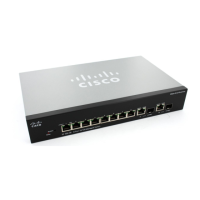Configuring the Spanning Tree Protocol
Configuring STP Status and Global Settings
Cisco Small Business 300 Series Managed Switch Administration Guide 129
12
Configuring STP Status and Global Settings
The STP Status and Global Settings Page contains parameters for enabling STP,
RSTP, or MSTP. For detailed configuration of each STP mode, use the STP
Interface Settings Page, RSTP Interface Settings Page, and MSTP Properties
Page, respectively.
To set STP status and global settings:
STEP 1 Click Spanning Tree > STP Status and Global Settings. The
STP Status and
Global Settings Page
displays.
STEP 2 Enter the parameters.
Global Settings:
• Spanning Tree State—Enable or disable STP on the switch.
• STP Operation Mode—Select an STP mode.
• Bridge Protocol Data Unit (BPDU) Handling—Select how BPDU packets
are managed when STP is disabled on the port or the switch. BPDUs are
used to transmit spanning tree information.
- Filtering—Filters BPDU packets when Spanning Tree is disabled on an
interface.
- Flooding—Floods BPDU packets when Spanning Tree is disabled on an
interface.
• Path Cost Default Values—Selects the method used to assign default path
costs to the STP ports. The default path cost assigned to an interface varies
according to the selected method.
- Short—Specifies the range 1 through 65,535 for port path costs.
- Long—Specifies the range 1 through 200,000,000 for port path costs.
Bridge Settings:
• Priority—Sets the bridge priority value. After exchanging BPDUs, the device
with the lowest priority becomes the Root Bridge. In the case that all bridges
use the same priority, then their MAC addresses are used to determine
which is the Root Bridge. The bridge priority value is provided in increments
of 4096. For example, 4096, 8192, 12288, and so on.

